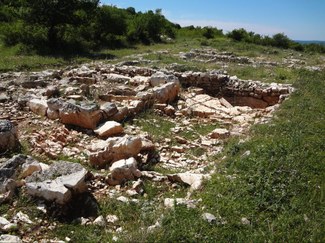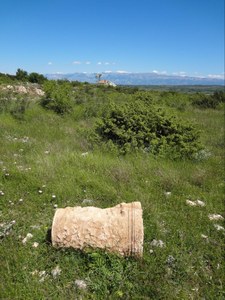A Liburnian Necropolis from Nadin, Croatia
A year ago, Tisa Loewen joined the ISAW Library team as one of our student workers. Tisa, a graduate student in NYU’s Physical Anthropology program, specializes in human skeletal biology and bioarchaeology. Last summer, the NYU Center for Ancient Studies granted Tisa a travel grant through the Antonina S. Ranieri International Scholars Fund, making possible her work on the skeletal remains from the excavations at Nadin (Nedinum), Croatia hosted by the University of Zadar (Sveučilište u Zadru). In this blog post, Tisa provides an overview of the Nadin site and her work there.
 The Gradina (fortress) of Nedinum is home to a hill fort archaeological site overlooking the Adriatic plains in the village of Nadin, Croatia, 22 km southeast of the coastal city of Zadar. Positioned below the Nadin hilltop lies a flat Iron Age Liburnian necropolis with single and multiple occupancy burials dating from between ~600-100 BCE, as well as later Roman burials and structural elements. At Nadin, I am charged with analysing the bones from the Liburnian necropolis in the hope that they can tell us something about the people of this region before and during the period of Roman influence.
The Gradina (fortress) of Nedinum is home to a hill fort archaeological site overlooking the Adriatic plains in the village of Nadin, Croatia, 22 km southeast of the coastal city of Zadar. Positioned below the Nadin hilltop lies a flat Iron Age Liburnian necropolis with single and multiple occupancy burials dating from between ~600-100 BCE, as well as later Roman burials and structural elements. At Nadin, I am charged with analysing the bones from the Liburnian necropolis in the hope that they can tell us something about the people of this region before and during the period of Roman influence.
The Liburnian people, who lived along the eastern Adriatic plain between the Istrian peninsula to the north and Krka River in the south, were a seafaring culture, economically entangled through trade with nearby societies. They inhabited this region from the Bronze age, starting around the 2nd millennium BCE, until they were assimilated into Roman Dalmatia during the first century BCE. Over that time, they engaged in a variety of subsistence practices for which isotopic and archaeological evidence show increased reliance on animal husbandry and agricultural trade.[1, 2] In addition, historical Greek texts and material culture from the region show conflict as well as trade between the Liburnians and various Hellenistic peoples.[3, 4] In the first century BCE, the city of Zadar, a main seaport and trading hub of the region, became a Roman municipium, and soon after, Roman influence spread throughout the region, altering previous ways of life.[5, 6]
A team from Zadar University excavated the necropolis in recent years to gain clarity on the inhabitants and to preserve the remains from further degradation. Led by Dr. Martina Celhar and colleagues from the University of Zadar, a multinational collaboration including archaeologist Dr. Gregory Zaro (University of Maine) and bioarchaeologist Dr. Kenneth Nystrom (SUNY New Paltz) has also been working on the hill fort and excavations from surrounding sites. This project is unique in Croatian archaeology. There are many architecturally spectacular Roman through Ottoman-era sites in Croatia, as well as large artifact hordes from lavish Bronze Age burials. Though lacking these grand attractions, the 32-hectare site of Nadin is distinguished by the fact that it is home to many complex layers of occupation. It was the first Liburnian site to be found to have the traditional burial tumuli as well as a flat necropolis, which differs from the nearby Bronze Age burial mounds.[7] It is also one of the few examples in the region of seemingly contemporaneous mixed burial styles. However, it is not a grand visual marvel such as Diocletian’s Palace in Split or the amphitheater in Pula. While some ancient structures remain at the apex of the hilltop, and the necropolis contains Liburnian and Roman stone-lined burials and wall foundations, many of the site's treasures were scattered across the site and many are still hidden underground.
Finds such as these have spurred such questions as: How did the Liburnians feed the population needed to build complex urban areas when the archaeological evidence suggests subsistence practices indicative of a relatively low population density?[8] Are all the archaeological changes we see in land use, animal husbandry, and diet evidence of urbanization? What were some of the environmental effects of these economic shifts and how did they affect the long-term ability of the hinterland to support the new urban populations?
 It is my hope that the skeletal remains will help us better to understand who we find at the site and what factors may lie behind the indicators of stress we find in their bones, for example, environmental pressures, disease, or change in diet. Due to many disturbances at the site, including Roman remodeling, modern looting, and multiple excavations, the human skeletal remains of the necropolis are heavily commingled and fragmentary. Therefore, I spent this past summer and winter in Zadar at the University carefully cataloging each human skeletal fragment from graves and plan to go back this summer. Previous osteological assessments of part of the necropolis found a potential change in the frequency of pathologies in the Liburnian people between the Early Iron Age and the Roman period. Authors suggest that times of hardship and shifting economics in the 5th century BCE may have affected the Liburnians’ health.[9, 10] There was indeed continued strain on the region throughout this period leading up to the Illyrian Wars (229-168 BCE) and subsequent conflicts.[11] However, Nadin was also growing, with new structures being built regularly. The population size and its subsistence needs seem to have been stable enough for the production of the architecture seen at the Gradina, making simple explanations alone inadequate.[12] While the Liburnians remained resilient through the turmoil of those 500 years, they eventually succumbed to the Roman Empire. It was that imperialism that "buried" not only their ancestral remains under Roman walls and a new Roman identity, but also removed Liburnian ways of life from memory. Fortunately, we have archaeology and anthropology to help us recover the Liburnian people and their culture.
It is my hope that the skeletal remains will help us better to understand who we find at the site and what factors may lie behind the indicators of stress we find in their bones, for example, environmental pressures, disease, or change in diet. Due to many disturbances at the site, including Roman remodeling, modern looting, and multiple excavations, the human skeletal remains of the necropolis are heavily commingled and fragmentary. Therefore, I spent this past summer and winter in Zadar at the University carefully cataloging each human skeletal fragment from graves and plan to go back this summer. Previous osteological assessments of part of the necropolis found a potential change in the frequency of pathologies in the Liburnian people between the Early Iron Age and the Roman period. Authors suggest that times of hardship and shifting economics in the 5th century BCE may have affected the Liburnians’ health.[9, 10] There was indeed continued strain on the region throughout this period leading up to the Illyrian Wars (229-168 BCE) and subsequent conflicts.[11] However, Nadin was also growing, with new structures being built regularly. The population size and its subsistence needs seem to have been stable enough for the production of the architecture seen at the Gradina, making simple explanations alone inadequate.[12] While the Liburnians remained resilient through the turmoil of those 500 years, they eventually succumbed to the Roman Empire. It was that imperialism that "buried" not only their ancestral remains under Roman walls and a new Roman identity, but also removed Liburnian ways of life from memory. Fortunately, we have archaeology and anthropology to help us recover the Liburnian people and their culture.
For more information:
If you’d like to know more about Iron Age and Roman archaeology in Croatia or this site in particular, check out these books currently held at the ISAW Library:
-
Ancient Illyria : An Archaeological Exploration by Arthur Evans (Small Collection DR 39 .5 .E93 2006)
-
The changing face of Dalmatia: archaeological and ecological studies in a Mediterranean landscape by J. Chapman, J., R. Shields, Š. Batović (Small Collection DR 1623 .C48 1996)
-
Dalmatia by J.J. Wilkes (Small Collection DG 59 .D4 W5 1969)
- Kroatien in der Antike by Mirjana Sanader (Oversize Collection DR 1521 .K76 2007)
References:
[1] Lightfoot, E., Šlaus, M., Šikanjić, P., & O’Connell, T., 2015. "Metals and millets: Bronze and Iron Age diet in inland and coastal Croatia seen through stable isotope analysis." Archaeological and Anthropological Sciences, 7(3), 375-386.
[2] Chapman, J., Shields, R., & Batović, Š. 1996. The changing face of Dalmatia: archaeological and ecological studies in a Mediterranean landscape. Reports of the Research Committee of the Society of Antiquaries of London, no. 54. London: Leicester Univ Press.
[3] Shipley, G. 2011. Pseudo-Skylax’s Periplous: The Circumnavigation of the Inhabited World: Text, Translation and Commentary. Exeter, England: Bristol Phoenix Press.
[4] Wilkes, J. 1969. Dalmatia. History of the Provinces of the Roman Empire. Cambridge, Mass.: Harvard University Press.
[5] Anterić, I., Bašić, Ž., Škorić, E., & Anđelinović, Š., 2010. "Nadin Flat Necropolis." Histria antiqua, 20, 145-154.
[6] Anterić, I., Bašić, Ž., & Anđelinović, Š. 2012. "Nadin–Rezultati Antropološke Analize Liburnske Populacije." Asseria, 9.
[7] Kukoč, Sineva. 2009 “Nadin-Liburnian Cult of the Dead; Research 2004.-2006., 2009.” Asseria 7: 11–80.
[8] Chapman, Shields & Batović 1996.
[9] Evans, Arthur. 2006. Ancient Illyria: An Archaeological Exploration. New York: I.B. Tauris in association with the Centre for Albanian Studies.
[10] Novak, Grga, Mirosavljević, V., Rendić-Miočević, D., and Suić, M. 1970. Adriatica praehistorica et antiqua. Zagreb: Sveučilište - Arheološki Institut Filozofskog fakulteta.
[12] Chapman, Shields & Batović 1996.